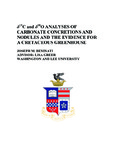δ13C and δ18O Analyses of Carbonate Concretions and Nodules and the Evidence for a Cretaceous Greenhouse (thesis)

View/
Author
Beninati, Joseph M. (Joe)
Subject
Washington and Lee University -- Honors in Geology
Cretaceous Geologic Period
Climatic changes -- Research
Carbonate rocks -- Composition
Alaska -- North Slope
Metadata
Show full item recordDescription
Thesis; [FULL-TEXT FREELY AVAILABLE ONLINE] Joseph M. Beninati is a member of the Class of 2016 of Washington and Lee University. The Aptian-Albian Torok Formation and Nanushuk Formation rocks of Slope Mountain, also known as the Marmot Syncline, have been interpreted to represent shallow marine, deltaic, and fluvial depositional environments. Middle-Cretaceous climate is most commonly interpreted as a greenhouse-world in which peak temperatures and atmospheric carbon dioxide (CO2) were as great as any other period in Earth's history. Carbonate nodules and concretions have been found throughout the Nanushuk Formation and Torok Formation. This study investigates the composition of local carbonate concretions and nodules in order to determine whether these samples can be used as paleoclimate proxies. We use x-ray diffraction (XRD) and δ18O and δ13C stable isotope analyses to extrapolate Middle-Cretaceous climate conditions. δ18O results range from 17.40 to 28.10‰ with an average value of 23.66‰. δ13C results range from -21.73 to 2.20‰ with an average value of -6.19‰. Our δ18O are in agreement with prior studies that suggest a consistently warm and greenhouse-world Middle-Cretaceous climate. The variance in our δ13C results may be the result of mixing between terrestrial and marine carbon during Slope Mountain deposition.